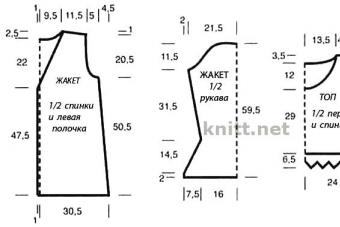Attention! The information is not intended for self-treatment, consult a specialist.
Caffetin ® Cold, description of the pharmacological action of the drug, possible side effects and contraindications
INSTRUCTIONS
on the medical use of the drug
KAFFETIN® COLD
(CAFFETIN® COLD)
Registration number: LSR-006775/09-250809
Tradename: KAFFETIN® COLD
International non-proprietary or grouping name: paracetamol + pseudoephedrine + dextromethorphan + ascorbic acid
Dosage form:
Compound
Active substances: 1 film-coated tablet contains paracetamol (paracetamol granules DC 90%) * 500.00 mg - 555.00 mg; pseudoephedrine hydrochloride 30 mg; dextromethorphan hydrobromide *** 15 mg and ascorbic acid (ascorbic acid DC 97%)** 60.00 mg-62.00 mg.
Excipients: colloidal silicon dioxide, magnesium stearate, croscarmellose sodium, talc, microcrystalline cellulose.
Shell: Opadry II blue (indigo carmine E132; macrogol (PEG 3350)); polyvinyl alcohol, partially hydrolyzed; talc; titanium dioxide E 171).
* Paracetamol is used in the form of granules: 1 g of granules contains about 900 mg of paracetamol
Paracetamol 90.00%
Pregelatinized starch 8.40%
Povidone (K-30) 0.60%
Stearic acid 1.00%
** ascorbic acid is used in the form of granulate: 1 g of granulate contains about 970 mg of ascorbic acid ascorbic acid 97%
hypromellose (hydroxypropyl methylcellulose) 3%
*** dextromethorphan hydrobromide according to Ph. Eur Dextromethorphan Hydrobromide Monohydrate
Description
Blue, oblong, biconvex, film-coated tablets with a notch on one side.
Pharmacotherapeutic group: Means for eliminating the symptoms of acute respiratory infections and "colds" (analgesic non-narcotic agent + sympathomimetic agent + antitussive opioid agent + vitamin)
ATC code: R01BA52
Pharmacological properties
Pharmacodynamics
Paracetamol has analgesic and antipyretic effects. In the central nervous system, it blocks cyclooxygenase, affecting the centers of pain and thermoregulation. Unlike non-steroidal anti-inflammatory drugs, paracetamol has practically no anti-inflammatory effect. It does not cause irritation of the mucous membrane of the stomach and intestines. It does not affect the water-salt metabolism, since it does not affect the synthesis of prostaglandins in peripheral tissues.
Pseudoephedrine constricts the vessels of the nasal and pharyngeal mucosa, reduces swelling, which leads to a decrease in secretion in the nasal cavity and facilitates nasal breathing.
Dextromethorphan acts on the cough center and raises the cough threshold, which leads to a decrease in dry cough associated with irritation of the nasopharyngeal mucosa in most "cold" diseases. Ascorbic acid compensates for the deficiency of vitamin C in "colds" diseases.
Pharmacokinetics
Absorption of paracetamol occurs mainly in the small intestine and the maximum plasma concentration is usually reached 0.5-1.5 hours after ingestion. The plasma half-life of paracetamol is 1.5-2.5 hours. It is metabolized in the liver (90-95%): 80% enters into conjugation reactions with glucuronic acid and sulfates to form inactive metabolites; 17% undergoes hydroxylation with the formation of 8 active metabolites, which are conjugated with glutathione to form already inactive metabolites. With a lack of glutathione, these metabolites can block the enzyme systems of hepatocytes and cause their necrosis. The CYP2E1 isoenzyme is also involved in the metabolism of the drug. T1 / 2 - 1-4 hours. Excreted by the kidneys in the form of metabolites, mainly conjugates, only 3% unchanged. In elderly patients, the clearance of the drug decreases and T1 / 2 increases.
Pseudoephedrine is well absorbed after oral administration, the maximum plasma concentration is reached after 1.5-2 hours. The plasma half-life is approximately 5.5 hours. Pseudoephedrine is partially metabolized in the liver with the formation of an active metabolite and excreted in the urine.
Dextromethorphan is well absorbed after oral administration and peak plasma concentrations are usually reached 2 hours after a dose. Dextromethorphan is metabolized in the liver and excreted in the urine unchanged and as metabolites. Ascorbic acid is completely absorbed in the gastrointestinal tract and well distributed in body tissues. Ascorbic acid is reversibly oxidized to dehydroxyascorbic acid, and partially metabolized to ascorbate-2-sulfate; excreted in the urine.
Indications for use
Symptomatic treatment of "colds" and influenza ( headache, muscle pain, sore throat, fever body, dry cough, runny nose, stuffy nose and paranasal sinuses).
Contraindications
Hypersensitivity to the drug or any of its components.
Arterial hypertension, coronary artery disease (ischemic heart disease), angina pectoris.
Severe liver or kidney dysfunction, hepatitis.
Simultaneous use of MAO inhibitors (monoamine oxidase), antidepressants, antiparkinsonian drugs. The use of MAO inhibitors (monoamine oxidase) in the previous two weeks before starting the drug
Congenital deficiency of glucose-6-phosphate dehydrogenase.
Children's age up to 12 years.
Pregnancy, lactation.
Carefully:
benign hyperbilirubinemia (including Gilbert's syndrome), viral hepatitis, alcoholism, arrhythmias, prostatic hyperplasia with urinary retention, diabetes mellitus, hyperthyroidism, bronchial asthma, COPD (chronic obstructive pulmonary disease), debilitated and malnourished patients.
Dosage and administration
The recommended dose of Caffetin Cold for adults and children over 12 years of age is one tablet 4 times a day. You can take 2 tablets at once. The interval between doses should be at least 4 hours. The maximum single dose is 2 tablets, and the maximum daily dose is 2 tablets 4 times within 24 hours.
If fever persists for more than 3 days from the start of treatment, and cough for more than 5 days, you should consult a doctor.
Side effect
From the digestive system: nausea, dry mouth, rarely - epigastric pain; with prolonged use in high doses, hepatotoxicity.
From the side of the central nervous system: drowsiness, irritability, agitation, rarely - dizziness.
allergic reactions: skin rash, pruritus, urticaria, angioedema.
From the side of the cardiovascular system: increased blood pressure, tachycardia.
On the part of the hematopoietic organs: rarely - anemia, thrombocytopenia, agranulocytosis, with prolonged use in high doses - hemolytic anemia, aplastic anemia, pancytopenia.
From the urinary system: with prolonged use in high doses, nephrotoxicity (renal colic, interstitial nephritis, papillary necrosis).
Overdose
Symptoms. Pseudoephedrine - irritability, anxiety, tremor, convulsions, arrhythmias, arterial hypertension. Paracetamol (especially in patients with impaired renal and hepatic function) - pallor of the skin, anorexia, nausea, vomiting, impaired liver function. Dextromethorphan - nausea, vomiting, dizziness, drowsiness, blurred vision, lethargy, impaired coordination of movement, difficulty breathing.
Treatment. Gastric lavage in the first 6 hours, followed by the appointment of activated charcoal, symptomatic therapy, the introduction of donators of SH-groups and precursors of the synthesis of glutathione-methionine 8-9 hours after an overdose and acetylcysteine - after 12 hours.
Interaction with others medicines
The concomitant use of paracetamol in high doses increases the effect of anticoagulant drugs. Inducers of microsomal oxidation in the liver (phenytoin, ethanol, barbiturates, rifampicin, phenylbutazone, tricyclic antidepressants) and hepatotoxic drugs increase the production of hydroxylated active metabolites of paracetamol, which makes it possible to develop severe intoxication even at a low dose.
Prolonged use of barbiturates reduces the effectiveness of paracetamol. Simultaneous long-term administration of paracetamol in high doses and salicylates increases the risk of developing kidney and bladder cancer. Long-term combined use of paracetamol and non-steroidal anti-inflammatory drugs (NSAIDs) increases the risk of developing "analgesic" nephropathy and renal papillary necrosis, accelerates the onset of end-stage renal failure.
Diflunisal increases the plasma concentration of paracetamol by 50%, thereby increasing the risk of developing hepatotoxicity.
With the simultaneous use of pseudoephedrine with other symlatomimetic drugs, an additive effect and the development of toxic effects are possible; with monoamine oxidase inhibitors - the development of a hypertensive crisis is possible (the drug can be used no earlier than 2 weeks after stopping the use of monoamine oxidase inhibitors).
Propranolol may enhance the pressor effect of pseudoephedrine; pseudoephedrine can reduce the hypotensive effect of reserpine, methyldopa, mecamylamine and hellebore alkaloids.
Amiodarone, fluoxetine, quinidine, by inhibiting the cytochrome P450 system, can increase the concentration of dextromethorphan in the blood.
special instructions
During the treatment period, peripheral blood parameters and the functional state of the liver are monitored.
During the period of treatment, it is necessary to refrain from drinking ethanol (possible development of a hepatotoxic effect) and caffeine, driving vehicles and engaging in other potentially hazardous activities that require increased concentration and psychomotor speed.
Release form
Film-coated tablets.
10 tablets in a perforated blister made of aluminum foil and a transparent three-layer film (PVC/TE/PVdC).
1 blister (10 tablets) together with instructions for use are placed in a cardboard box.
Storage conditions
Store at a temperature not exceeding 25 ° C, out of the reach of children.
Best before date
2 years. Do not use after the expiration date.
Terms of dispensing from pharmacies
Leave by prescription.
Manufacturer
ALKALOID SA, Republic of Macedonia. Boulevard Aleksandar Makedonski 12, 1000 Skopje.
Address of the Moscow representative office: 117292 Moscow, st. Dmitry Ulyanov 16/2 - 267
When packing the drug at PharmFirma Sotex CJSC, consumer claims should be sent to: 141345, Moscow region, Sergiev Posad district, Svatkovo village, p/o Svatkovo
Foreign name of the drug: Caffetin ® Cold
On this page you can get maximum information about such medicine as Caffetin® Cold. Read the description and indications of Caffetin® Cold, learn about possible side effects and contraindications. Having learned about the active substance and the pharmacological action of such a drug as Caffetin® Cold, you will become clear in the treatment of which diseases the drug can be used and which doctor to contact to undergo medical measures and avoid serious consequences and complications. The use of pharmacological drugs is not recommended from a long-term health point of view, and most drugs have contraindications for use. You can also see a photo of the drug and find out if it is possible side effects when taking Caffetin® Cold and other medicines at the same time, as well as prices in the nearest pharmacies and alternatives to this drug.
Description of the drug Caffetin ® Cold is not intended for prescribing treatment without the participation of a doctor. LSR-006775/09-250809
Tradename: KAFFETIN® COLD
International non-proprietary or grouping name: paracetamol + pseudoephedrine + dextromethorphan + ascorbic acid
Dosage form:
Compound
Active substances: 1 film-coated tablet contains paracetamol (paracetamol granules DC 90%) * 500.00 mg - 555.00 mg; pseudoephedrine hydrochloride 30 mg; dextromethorphan hydrobromide *** 15 mg and ascorbic acid (ascorbic acid DC 97%)** 60.00 mg-62.00 mg.
Excipients: colloidal silicon dioxide, magnesium stearate, croscarmellose sodium, talc, microcrystalline cellulose.
Shell: Opadry II blue (indigo carmine E132; macrogol (PEG 3350)); polyvinyl alcohol, partially hydrolyzed; talc; titanium dioxide E 171).
* Paracetamol is used in the form of granules: 1 g of granules contains about 900 mg of paracetamol
Paracetamol 90.00%
Pregelatinized starch 8.40%
Povidone (K-30) 0.60%
Stearic acid 1.00%
** ascorbic acid is used in the form of granulate: 1 g of granulate contains about 970 mg of ascorbic acid ascorbic acid 97%
hypromellose (hydroxypropyl methylcellulose) 3%
*** dextromethorphan hydrobromide according to Ph. Eur Dextromethorphan Hydrobromide Monohydrate
Description
Blue, oblong, biconvex, film-coated tablets with a notch on one side.
Pharmacotherapeutic group:
Means for eliminating the symptoms of acute respiratory infections and "colds" (analgesic non-narcotic agent + sympathomimetic agent + antitussive opioid agent + vitamin)ATC code: R01BA52
Pharmacological properties
Pharmacodynamics
Paracetamol has analgesic and antipyretic effects. In the central nervous system, it blocks cyclooxygenase, affecting the centers of pain and thermoregulation. Unlike non-steroidal anti-inflammatory drugs, paracetamol has practically no anti-inflammatory effect. It does not cause irritation of the mucous membrane of the stomach and intestines. It does not affect the water-salt metabolism, since it does not affect the synthesis of prostaglandins in peripheral tissues.
Pseudoephedrine constricts the vessels of the nasal and pharyngeal mucosa, reduces swelling, which leads to a decrease in secretion in the nasal cavity and facilitates nasal breathing.
Dextromethorphan acts on the cough center and raises the cough threshold, which leads to a decrease in dry cough associated with irritation of the nasopharyngeal mucosa in most "cold" diseases. Ascorbic acid compensates for the deficiency of vitamin C in "colds" diseases.
Pharmacokinetics
Absorption of paracetamol occurs mainly in the small intestine and the maximum plasma concentration is usually reached 0.5-1.5 hours after ingestion. The plasma half-life of paracetamol is 1.5-2.5 hours. It is metabolized in the liver (90-95%): 80% enters into conjugation reactions with glucuronic acid and sulfates to form inactive metabolites; 17% undergoes hydroxylation with the formation of 8 active metabolites, which are conjugated with glutathione to form already inactive metabolites. With a lack of glutathione, these metabolites can block the enzyme systems of hepatocytes and cause their necrosis. The CYP2E1 isoenzyme is also involved in the metabolism of the drug. T1 / 2 - 1-4 hours. Excreted by the kidneys in the form of metabolites, mainly conjugates, only 3% unchanged. In elderly patients, the clearance of the drug decreases and T1 / 2 increases.
Pseudoephedrine is well absorbed after oral administration, the maximum plasma concentration is reached after 1.5-2 hours. The plasma half-life is approximately 5.5 hours. Pseudoephedrine is partially metabolized in the liver with the formation of an active metabolite and excreted in the urine.
Dextromethorphan is well absorbed after oral administration and peak plasma concentrations are usually reached 2 hours after a dose. Dextromethorphan is metabolized in the liver and excreted in the urine unchanged and as metabolites. Ascorbic acid is completely absorbed in the gastrointestinal tract and well distributed in body tissues. Ascorbic acid is reversibly oxidized to dehydroxyascorbic acid, and partially metabolized to ascorbate-2-sulfate; excreted in the urine.
Indications for use
Symptomatic treatment of "colds" and influenza (headache, muscle pain, sore throat, fever, dry cough, runny nose, nasal congestion and paranasal sinuses).
Contraindications
Hypersensitivity to the drug or any of its components.
Arterial hypertension, coronary artery disease (ischemic heart disease), angina pectoris.
Severe liver or kidney dysfunction, hepatitis.
Simultaneous use of MAO inhibitors (monoamine oxidase), antidepressants, antiparkinsonian drugs. The use of MAO inhibitors (monoamine oxidase) in the previous two weeks before starting the drug
Congenital deficiency of glucose-6-phosphate dehydrogenase.
Children's age up to 12 years.
Pregnancy, lactation.
Carefully:
benign hyperbilirubinemia (including Gilbert's syndrome), viral hepatitis, alcoholism, arrhythmias, prostatic hyperplasia with urinary retention, diabetes mellitus, hyperthyroidism, bronchial asthma, COPD (chronic obstructive pulmonary disease), debilitated and malnourished patients.
Dosage and administration
The recommended dose of Caffetin Cold for adults and children over 12 years of age is one tablet 4 times a day. You can take 2 tablets at once. The interval between doses should be at least 4 hours. The maximum single dose is 2 tablets, and the maximum daily dose is 2 tablets 4 times within 24 hours.
If fever persists for more than 3 days from the start of treatment, and cough for more than 5 days, you should consult a doctor.
Side effect
From the digestive system: nausea, dry mouth, rarely - epigastric pain; with prolonged use in high doses, hepatotoxicity.
From the side of the central nervous system: drowsiness, irritability, agitation, rarely - dizziness.
Allergic reactions: skin rash, pruritus, urticaria, angioedema.
From the side of the cardiovascular system: increased blood pressure, tachycardia.
On the part of the hematopoietic organs: rarely - anemia, thrombocytopenia, agranulocytosis, with prolonged use in high doses - hemolytic anemia, aplastic anemia, pancytopenia.
From the urinary system: with prolonged use in high doses, nephrotoxicity (renal colic, interstitial nephritis, papillary necrosis).
Overdose
Symptoms. Pseudoephedrine - irritability, anxiety, tremor, convulsions, arrhythmias, arterial hypertension. Paracetamol (especially in patients with impaired renal and hepatic function) - pallor of the skin, anorexia, nausea, vomiting, impaired liver function. Dextromethorphan - nausea, vomiting, dizziness, drowsiness, blurred vision, lethargy, impaired coordination of movement, difficulty breathing.
Treatment. Gastric lavage in the first 6 hours, followed by the appointment of activated charcoal, symptomatic therapy, the introduction of donators of SH-groups and precursors of the synthesis of glutathione-methionine 8-9 hours after an overdose and acetylcysteine - after 12 hours.
Interaction with other drugs
The concomitant use of paracetamol in high doses increases the effect of anticoagulant drugs. Inducers of microsomal oxidation in the liver (phenytoin, ethanol, barbiturates, rifampicin, phenylbutazone, tricyclic antidepressants) and hepatotoxic drugs increase the production of hydroxylated active metabolites of paracetamol, which makes it possible to develop severe intoxication even at a low dose.
Prolonged use of barbiturates reduces the effectiveness of paracetamol. Simultaneous long-term administration of paracetamol in high doses and salicylates increases the risk of developing kidney and bladder cancer. Long-term combined use of paracetamol and non-steroidal anti-inflammatory drugs (NSAIDs) increases the risk of developing "analgesic" nephropathy and renal papillary necrosis, accelerates the onset of end-stage renal failure.
Diflunisal increases the plasma concentration of paracetamol by 50%, thereby increasing the risk of developing hepatotoxicity.
With the simultaneous use of pseudoephedrine with other symlatomimetic drugs, an additive effect and the development of toxic effects are possible; with monoamine oxidase inhibitors - the development of a hypertensive crisis is possible (the drug can be used no earlier than 2 weeks after stopping the use of monoamine oxidase inhibitors).
Propranolol may enhance the pressor effect of pseudoephedrine; pseudoephedrine can reduce the hypotensive effect of reserpine, methyldopa, mecamylamine and hellebore alkaloids.
Amiodarone, fluoxetine, quinidine, by inhibiting the cytochrome P450 system, can increase the concentration of dextromethorphan in the blood.
special instructions
During the treatment period, peripheral blood parameters and the functional state of the liver are monitored.
During the period of treatment, it is necessary to refrain from drinking ethanol (possible development of a hepatotoxic effect) and caffeine, driving vehicles and engaging in other potentially hazardous activities that require increased concentration and psychomotor speed.
Release form
Film-coated tablets.
10 tablets in a perforated blister made of aluminum foil and a transparent three-layer film (PVC/TE/PVdC).
1 blister (10 tablets) together with instructions for use are placed in a cardboard box.
Storage conditions
Store at a temperature not exceeding 25 ° C, out of the reach of children.
Best before date
2 years. Do not use after the expiration date.
Terms of dispensing from pharmacies
Leave by prescription.
Manufacturer
ALKALOID SA, Republic of Macedonia. Boulevard Aleksandar Makedonski 12, 1000 Skopje.
Address of the Moscow representative office: 117292 Moscow, st. Dmitry Ulyanov 16/2 - 267
When packing the drug at PharmFirma Sotex CJSC, consumer claims should be sent to: 141345, Moscow region, Sergiev Posad district, Svatkovo village, p/o Svatkovo
Drug for symptomatic therapy of acute respiratory diseases
Release form, composition and packaging
10 pieces. - cellular contour packings (1) - packs of cardboard.
pharmachologic effect
Paracetamol has analgesic and antipyretic action. In the central nervous system, it blocks cyclooxygenase, affecting the centers of pain and thermoregulation. Unlike non-steroidal anti-inflammatory drugs, paracetamol has practically no anti-inflammatory effect. Does not cause irritation of the mucous membrane of the stomach and intestines. It does not affect the water-salt metabolism, since it does not affect the synthesis of prostaglandins in peripheral tissues.
pseudoephedrine promotes vasoconstriction of the mucous membrane of the nose and pharynx, reduces swelling, which leads to a decrease in secretion in the nasal cavity and facilitates nasal breathing.
Dextromethorphan acts on the cough center and increases the cough threshold, which leads to a decrease in dry cough associated with irritation of the nasopharyngeal mucosa in most "cold" diseases.
Ascorbic acid replenishes vitamin C deficiency in "cold" diseases.
Pharmacokinetics
Suction paracetamol occurs mainly in the small intestine and the maximum plasma concentration is usually reached 0.5-1.5 hours after ingestion. The plasma half-life of paracetamol is 1.5-2.5 hours. It is metabolized in the liver (90-95%): 80% enters into conjugation reactions with glucuronic acid and sulfates to form inactive metabolites; 17% undergoes hydroxylation with the formation of 8 active metabolites, which conjugate with glutathione to form already inactive metabolites. With a lack of glutathione, these metabolites can block the enzyme systems of hepatocytes and cause their necrosis. The CYP2E1 isoenzyme is also involved in the metabolism of the drug, T 1/2 - 1-4 hours. It is excreted by the kidneys in the form of metabolites, mainly conjugates, only 3% unchanged. In elderly patients, the clearance of the preiarat decreases and T 1/2 increases.
pseudoephedrine well absorbed after oral administration, the maximum plasma concentration is reached after 1.5-2 hours. The plasma half-life is approximately 5.5 hours. Pseudoephedrine is partially metabolized in the liver to form an active metabolite and excreted in the urine.
Dextromethorphan well absorbed after oral administration and the maximum plasma concentration is usually reached 2 hours after a dose. Dextromethorphan is metabolized in the liver and excreted in the urine unchanged and as metabolites.
Ascorbic acid is completely absorbed in the gastrointestinal tract and is well distributed in body tissues. Ascorbic acid is reversibly oxidized to dehydroxyascorbic acid, and partially metabolized to ascorbate-2-sulfate; excreted in the urine.
Indications
- symptomatic treatment of colds and flu (headache, muscle pain, sore throat, fever, dry cough, runny nose, nasal congestion and paranasal sinuses).
Contraindications
- hypersensitivity to the drug or any of its components;
- arterial hypertension, coronary artery disease (ischemic heart disease), angina pectoris;
- severe violations of the liver or kidneys, hepatitis;
- simultaneous use of MAO inhibitors (monoamine oxidase), antidepressants, antiparkiison drugs;
- the use of MAO inhibitors (monoamine oxidase) in the previous two weeks before starting the drug;
- congenital deficiency of glucose-6-phosphate dehydrogenase;
— childhood up to 12 years;
- pregnancy, lactation.
Carefully: benign hyperbilirubinemia (including Gilbert's syndrome), viral hepatitis, alcoholism, arrhythmias, prostatic hyperplasia with urinary retention, diabetes mellitus, hyperthyroidism, bronchial asthma, COPD (chronic obstructive pulmonary disease), debilitated and malnourished patients.
Dosage
The recommended dose of Caffetin Cold for adults and children over 12 years of age is one tablet 4 times a day. You can take 2 tablets at once. The interval between doses should be at least 4 hours. The maximum single dose is 2 tablets, and the maximum daily dose is 2 tablets 4 times within 24 hours.
If fever persists for more than 3 days from the start of treatment, and cough for more than 5 days, you should consult a doctor.
Side effects
From the digestive system: nausea, dry mouth, rarely - epigastric pain; with prolonged use in high doses, hepatotoxicity.
From the side of the central nervous system: drowsiness, irritability, agitation, rarely - dizziness.
Allergic reactions: skin rash, pruritus, urticaria, angioedema.
From the side of the cardiovascular system: increased blood pressure, tachycardia.
From the side of the hematopoietic organs: rarely - anemia, thrombocytopenia, agranulocytosis, with prolonged use in high doses - hemolytic anemia, aplastic anemia, pancytopenia.
From the urinary system: with prolonged use in high doses, nephrotoxicity (renal colic, interstitial nephritis, papillary necrosis).
Overdose
Symptoms. Pseudoephedrine - irritability, anxiety, tremor, convulsions, arrhythmias, arterial hypertension.
Paracetamol (especially in patients with impaired renal and hepatic function) - pallor of the skin, anorexia, nausea, vomiting, impaired liver function.
Dextromethorphan - nausea, vomiting, dizziness, drowsiness, blurred vision, lethargy, impaired coordination of movement, difficulty breathing.
Treatment. Gastric lavage in the first 6 hours, followed by the appointment of activated charcoal, symptomatic therapy, the introduction of donators of SH-groups and precursors of the synthesis of glutathione-methionine 8-9 hours after an overdose and acetylcysteine - after 12 hours.
drug interaction
The concomitant use of paracetamol in high doses increases the effect of anticoagulant drugs.
Inducers of microsomal oxidation in the liver (phenytoin, ethanol, barbiturates, rifampicin, phenylbutazone, tricyclic antidepressants) and hepatotoxic drugs increase the production of hydroxylated active metabolites of paracetamol, which makes it possible to develop severe intoxication even at a low dose.
Prolonged use of barbiturates reduces the effectiveness of paracetamol.
Simultaneous long-term administration of paracetamol in high vines and salicylates increases the risk of developing kidney and bladder cancer. Long-term combined use of paracetamol and non-steroidal anti-inflammatory drugs (NSAIDs) increases the risk of developing "analgesic" nephropathy and renal papillary necrosis, accelerates the onset of end-stage renal failure.
Diflunisal increases the plasma concentration of paracetamol by 50%, thereby increasing the risk of developing hepatotoxicity.
With the simultaneous use of pseudoephedrine with other sympathomimetic drugs, an additive effect and the development of toxic effects are possible; with monoamine oxidase inhibitors - the development of a hypertensive crisis is possible (the drug can be used no earlier than 2 weeks after stopping the use of monoamine oxidase inhibitors).
Propranolol may enhance the pressor effect of pseudoephedrine; pseudoephedrine can reduce the hypotensive effect of reserpine, methyldopa, mecamylamine and hellebore alkaloids.
Amiodarone, fluoxetine, quinidine, by inhibiting the cytochrome P450 system, can increase the concentration of dextromethorphan in the blood.
special instructions
During the treatment period, peripheral blood parameters and the functional state of the liver are monitored.
For impaired liver function
Contraindicated in severe liver dysfunction.
Terms of dispensing from pharmacies
On prescription.
Terms and conditions of storage
Store at a temperature not exceeding 25 ° C, out of the reach of children. Shelf life - 2 years





